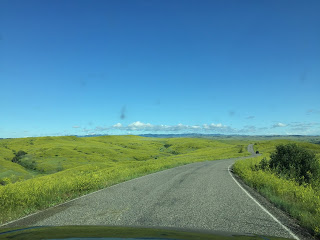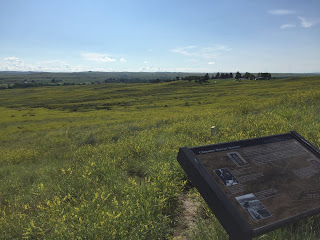The location is SE Montana and nearly 7 hours drive from Jackson so we had a great drive mainly through prairies and small towns like Cody, named after Buffalo Bill which is your ultimate one horse town. Really enjoyable. I think we went through two iPlayer stories and maybe a podcast or so. This did mean that we got there late, around 4 pm, but as it is just about the lightest time of the year and pretty far north, it wouldn't get dark until well past 10 pm. It was also a beautiful clear evening.
The visitor place is interesting and gave a nice background. We sat through the video but more interestingly a native Indian ranger's talk on the events with her perspective. Both sides in fact.
I didn't know what to expect really but as we'd driven 7 hours across prairie without seeing too many people, I had started to get an idea what it may have been like 150 years ago... no roads, no towns, just prairie. No telephone or radios, just wireless but without the wires which helped not at all. So with no communications means, hindsight would say that the objective of the punitive expedition was almost certainly doomed to failure. Obviously, the actual events were unexpected but ...
 |
| 1851 Treaty of Laramie that set the Sioux lands |
So many books have been written about the subject by so many different people with different perspectives that I won't add my two pennyworth, but here is Wikipedia's take on things. From what I saw and heard and subsequently read, it does seem to have been a series of errors, misunderstandings and simple cock ups combined with a lot of bad luck, rather like the Battle of Isandlwana in the South African Zulu wars and with a very similar aftermath: ultimate destruction for the victors.
The land area firstly is huge and the numbers of participants on either side were relatively few. In total some 8,000 Indians and on the US Army side, no more than 5,000 soldiers and cavalry split into two columns. The intent was to approach the Indians from two sides and deal with them that way. In practice, as soon as they split up there was no chance of subsequent coordination of any attack. Each column would have to deal with things as they came up all alone. The main body of soldiers didn't show up until 2-3 days later by which time it was all far too late and the Indians had long gone.
 |
| The ridge line along which the battle was fought |
 |
| Rolling ground with many gullies where Indian braves could hide and ridges from which they could shoot |
 |
| Last stand hill |
However what cannot be gainsaid is that all those that participated in the battle were doing it for what they deemed right reasons and for the most part fought and died bravely. This memorial I think does remember that very well indeed.
In writing this, just thinking that whenever history books are written, what people remember most are the times when things go wrong. Like here. The Battle of the Little Big Horn is one of the main high points in the history of the Wild West, at least as taught to British school children like me at the time. I cannot remember a single subsequent battle that took place that went the other way. Same as in the South African conflict that I mentioned earlier. Everyone remembers Isandlwana as a total fiasco and annihilation of a British army at the hands of the Zulus and the ensuing encounter at Rorke's Drift which in reality had zero effect on the war but was an amazingly fortunate encounter that caught the public eye. Nobody remembers the rest of the war, the battles nor even the treaty that ended it. Just the fiasco. Curious that.




No comments:
Post a Comment